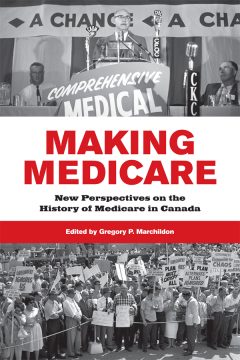Medicare is a fact of life and death in Canada. Yet, as editor Gregory Marchildon notes, the story of universal health insurance is little known.
“Why have historians devoted so little attention to the history of medicare?” asks Marchildon. There is no single inventor, no drama, no arresting narrative. It is the story of patchwork initiatives that evolved over generations.
Making Medicare fills the void. Contributors in a series of essays recount the Canadian struggle for public health insurance. The result is insightful and surprising, like the story of the “cottage hospitals” of Newfoundland & Labrador.
In 1936 Newfoundland, then a British colony, opened its first public hospital in the fishing village of Old Perlican. In time nearly two dozen cottage hospitals were established across the island.
The timing was desperate. Newfoundland had bankrupted itself in 1934. Half the province was out of work, and debt payments comprised 65 percent of the island budget. Newfoundland was so broke its premier offered to sell Labrador to the Government of Canada for $110 million.
Instead the colony suspended its constitution and surrendered its sovereignty to Britain. “The unforgettable thing about Newfoundland for most of those years before Confederation is that we were poor,” wrote Joey Smallwood. “We were a poor people, a poor country; the poorest in North America.”
The island had the highest infant mortality rate in the English-speaking world. Tuberculosis was epidemic. Harold Horwood, a member of Smallwood’s cabinet, later recalled that with cod and molasses few Newfoundlanders actually starved, but were malnourished.
“Outport Newfoundlanders had always lived off the land, and they continued to do so, right through the 1930s,” recalled Horwood. “Most of them were very poor; their houses were unpainted; their clothing wore out and could not be replaced; thousands of children had no boots or shoes, and some of them stayed out of school because of lack of clothes.”
Outside St. John’s there were only five hospitals in all Newfoundland including two clinics owned by paper mills, and a mining company hospital in Buchans. The alternative to public hospital insurance was no insurance at all.
Under U.K. administrators, the island adopted a public health system modeled on a program in the Scottish Highlands. The cottage hospitals had up to 30 beds. Each had a doctor on government salary. Families paid an annual premium of $5 for unlimited medical care.
It was “one of North America’s earliest efforts at publicly-funded health care,” notes Making Medicare. The system survived Confederation through to the introduction of Parliament’s 1957 Hospital Insurance and Diagnostic Services Act that subsidized all provincial insurance plans.
Today only a handful of cottage hospital buildings remain in Newfoundland. And the Old Perlican hospital, first of its kind? It was rebuilt and renamed in 1986, and remains in service.
By Holly Doan
Making Medicare: New Perspectives on the History of Medicare in Canada edited by Gregory P. Marchildon; University of Toronto Press; 336 pages; ISBN 9781-4426-13454; $39.95








